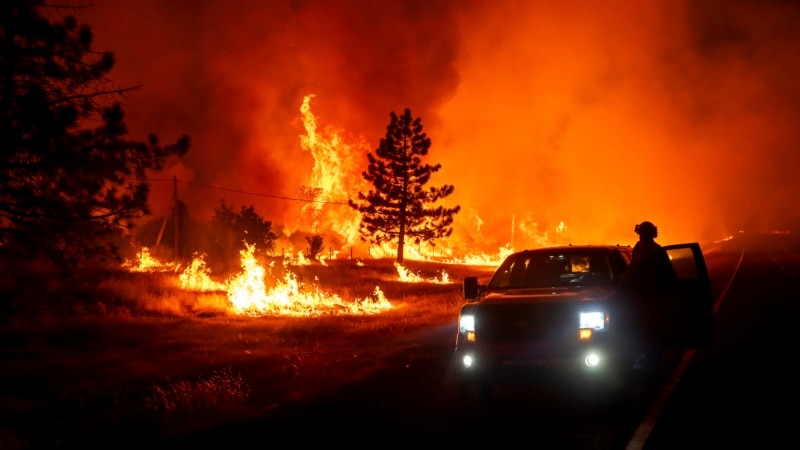Thousands of firefighters battling a massive wildfire in Northern California got some help from the weather hours after the blaze suddenly grew to cover an area larger than Los Angeles.
It is one of several active fires in the western United States and Canada, fueled by wind and heat.
A drop in temperature and increased humidity could help curb the Park Fire, the largest fire in California this year.
Its intensity and dramatic growth prompted fire chiefs to draw unflattering comparisons to the monstrous Camp Fire, which raged out of control in nearby Paradise in 2018, killing 85 people and burning 11,000 homes.
Paradise was back in the danger zone Saturday. The entire town was under evacuation alert, as were other towns in Butte County. Evacuation orders were also issued in Plumas, Tehama and Shasta counties.
An evacuation alert asks people to prepare to leave and await further instructions, while an evacuation order tells people to leave immediately.
Temperatures were expected to be cooler than average by the middle of next week, though “that doesn’t mean the existing fires are going to go away,” said Mac Chenard, a weather forecaster at the National Weather Service Prediction Center in College Park, Maryland.
By Saturday, the Park Fire had burned 1,416 square kilometers and destroyed 134 structures since it began Wednesday, when authorities said a man pushed a burning car into a ravine in Chico before fleeing. The fire was 10 percent contained and moving north and east near Chico.
Nearly 2,500 firefighters were battling the flames with the assistance of 16 helicopters and numerous air tankers.
Cal Fire Section Chief Jeremy Pierce said firefighters were taking advantage of the cooler weather while it lasted. “We’re having a lot of success today,” he said.
Susan Singleton and her husband packed their pickup truck with clothes, some food and their seven dogs and rushed to evacuate their home this week in Cohasset, a town of about 400 people northwest of Chico. They later learned their house had burned down.
In total, more than 110 active fires covered 7,250 square kilometers in the United States as of Friday, according to the National Interagency Fire Center.
In Southern California, a wildfire in Sequoia National Park devastated the community of Havilah, burning more than 124 square kilometers in less than three days. The town of 250 residents was under evacuation orders.
Crews were also making slow progress on a fire system in the Plumas National Forest near the California-Nevada border, said Forest Service spokeswoman Adrienne Freeman. There was a backlog of several miles near the border on the main highway connecting Los Angeles and Las Vegas.
The worst damage so far was in Jasper National Park in the Canadian Rockies, where 25,000 people were forced to flee and the town that gives the park its name, a World Heritage site, was devastated with 358 of the town’s 1,113 structures destroyed.
In eastern Washington, crews stopped advancing on a fire near Tyler late Friday that destroyed three homes and five outbuildings, according to the Washington Department of Natural Resources.
Two fires in eastern Oregon, the Durkee and Cow fires, have burned about 660 square miles (1,709 square kilometers).
And in Idaho, homes, outbuildings and a commercial building were lost in several towns, including Juliaetta, which was evacuated Thursday. The cluster of fires designated as the Gwen Fire was estimated to be 42 square miles (106 square kilometers) in size and was not contained.
Connect with the Voice of America! Subscribe to our channels Youtube, WhatsApp and the newsletter. Activate notifications and follow us on Facebook, X and Instagram.
















Add Comment